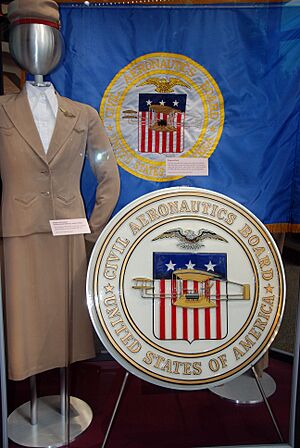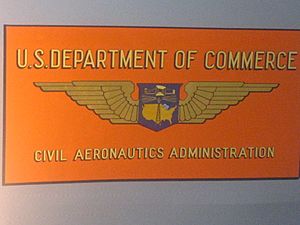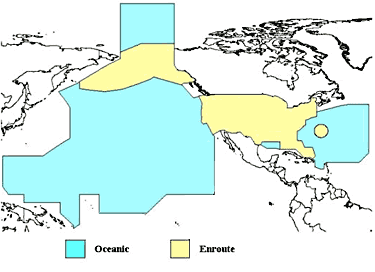United States government role in civil aviation facts for kids
The history of flying in the United States is full of important changes. Over time, the government created different groups to make sure flying was safe and organized. These groups helped planes fly smoothly, investigated accidents, and even helped develop new flying technology. From early mail planes to today's busy airports, the way we fly has changed a lot, thanks to these efforts.
Contents
- Early Days of Flight: Safety and Airmail
- The Air Commerce Act: Making Flying Safer
- Bureau of Air Commerce: New Navigation and Growth
- Civil Aeronautics Authority: New Agencies for Safety
- Federal Aviation Administration and NASA: Modern Air Control
- Department of Transportation and TSA: Protecting Travel
Early Days of Flight: Safety and Airmail
Flying became very popular in Europe around the time of World War I in 1914. The United States Congress wanted to improve American aviation too. In 1915, they created the National Advisory Committee for Aeronautics (NACA). This group focused on the science of flight.
When the U.S. joined World War I in 1917, the country's economy changed to support the war. This included making more airplanes. Before the war ended, Congress decided to fund a new postal program. This program, called airmail, would deliver mail by plane. It started in 1918 with help from the U.S. Army. The Post Office then took over. Airmail pilots helped create routes across the country and even developed lighted airways to fly at night.
In 1925, the Airmail Act allowed the Post Office to hire private airlines to carry mail. This was a big step for commercial flying in America. Many of today's famous airlines, like Trans World Airlines, Northwest Airlines, and United Airlines, started by carrying airmail in the late 1920s.
The Air Commerce Act: Making Flying Safer
In the early 1900s, there were no rules for flying in the United States. Many accidents happened, especially with "barnstormers" – pilots who performed stunts. These accidents made people worried about how safe air travel was. In 1924, barnstormers were involved in most fatal accidents. Some people didn't want the government to get involved, but the aviation industry knew that rules were needed to make flying safer and more popular.
President Calvin Coolidge asked a group to study the problem. They agreed that federal safety rules were important. So, on May 20, 1926, the Air Commerce Act became law.
This Act created the Aeronautic Branch within the United States Department of Commerce. This new group had the power to make flying safer. Their jobs included:
- Testing and licensing pilots.
- Making sure aircraft were safe to fly.
- Creating and enforcing safety rules.
- Setting up airways (like roads in the sky).
- Operating navigation aids (tools to help pilots find their way).
- Investigating accidents.
The first head of this Branch was William P. MacCracken, Jr.. Even with these new rules, some big accidents still happened, like the 1931 Transcontinental & Western Air Fokker F-10 crash.
The Department of Commerce focused on safety rules and certifying pilots and planes. They also took over building and running the nation's system of lighted airways, which the Post Office had started. They improved radio communication for planes and introduced radio beacons to help pilots navigate.
In 1934, the Aeronautic Branch changed its name to the Bureau of Air Commerce. As commercial aviation grew, the Bureau encouraged airlines to set up three centers in Newark, Cleveland, and Chicago. These centers helped control air traffic. In 1936, the Bureau took over these centers and started to expand the air traffic control (ATC) system. Early air traffic controllers used maps and calculations to make sure planes didn't crash into each other.
The Aeronautics Branch, created in 1926, was led by William P. MacCracken, Jr.. He worked with the aviation industry to create rules. A big goal was to improve the nation's air navigation system. The Branch took over building airway light beacons from the Post Office. In 1928, they introduced a new navigation system called the "Four Course Radio Range." They also built more communication stations to help pilots use radios and deal with bad weather.
NACA, the group focused on flight science, started its own research in 1920. In 1928, they used their wind tunnels to create a new type of engine cover that made planes more aerodynamic.
Under President Franklin D. Roosevelt, the Aeronautics Branch worked with public agencies on projects that helped build airports. In 1934, the Branch was reorganized and renamed the Bureau of Air Commerce.
In 1935, the Bureau of Air Commerce encouraged airlines to set up the first three air traffic control centers in Newark, Cleveland, and Chicago. The next year, the Bureau took over these centers and expanded the system.
Civil Aeronautics Authority: New Agencies for Safety

In 1938, the Civil Aeronautics Act moved federal responsibilities for non-military flying from the Bureau of Air Commerce to a new, independent agency called the Civil Aeronautics Authority. This law also gave the Authority the power to set airline ticket prices and decide which routes airlines could fly.
In 1940, President Franklin D. Roosevelt split the Authority into two groups:
- The Civil Aeronautics Administration (CAA) was in charge of air traffic control, safety programs, and developing airways.
- The Civil Aeronautics Board (CAB) handled safety rules, accident investigations, and economic rules for airlines.
Even though both were part of the Department of Commerce, the CAB worked independently. When a plane crashed in 1940, the CAB had its first big investigation, setting the standard for how accidents would be looked into.
After World War II started in Europe, the CAA began a program to train new pilots. As America entered the war, the agency started running airport control towers, a job they still do today. During the war, the CAA also greatly expanded its air traffic control system for planes flying between airports. In 1944, the U.S. hosted a meeting in Chicago that led to the creation of the International Civil Aviation Organization. This group set up rules for international aviation. In 1946, Congress gave the CAA the job of helping to develop civil airports in the United States.
Federal Aviation Administration and NASA: Modern Air Control
In the mid-1900s, there were several mid-air collisions, including one in 1956 that killed over 100 people. This was a time when jet travel was just beginning. These accidents led to the Federal Aviation Act of 1958. This law created a new independent group called the Federal Aviation Agency. The new FAA took over the CAA's jobs. It also took over safety rulemaking from the CAB and became responsible for a shared system of air navigation and air traffic control for both civil and military planes. The first head of the FAA was Elwood R. Quesada.
In the same year, the National Advisory Committee for Aeronautics (NACA), which was founded in 1915, became the National Aeronautics and Space Administration (NASA). This happened after the Soviet Union launched the first artificial satellite, Sputnik. NASA took over NACA's role of researching aviation and space.
Department of Transportation and TSA: Protecting Travel
In 1967, the job of investigating accidents was moved from the Civil Aeronautics Board to a new group called the National Transportation Safety Board. At the same time, the United States Department of Transportation was created.
The CAB's remaining power was to control airline routes and fares. However, the Airline Deregulation Act of 1978 gradually removed these controls, and the CAB closed down at the end of 1984.
The September 11, 2001 attacks showed a new type of terrorist threat: hijacked airliners used as weapons. The government responded by creating the Transportation Security Administration (TSA) in November 2001. The TSA was given wide-ranging powers to protect air travel and other types of transportation from criminal activity.



